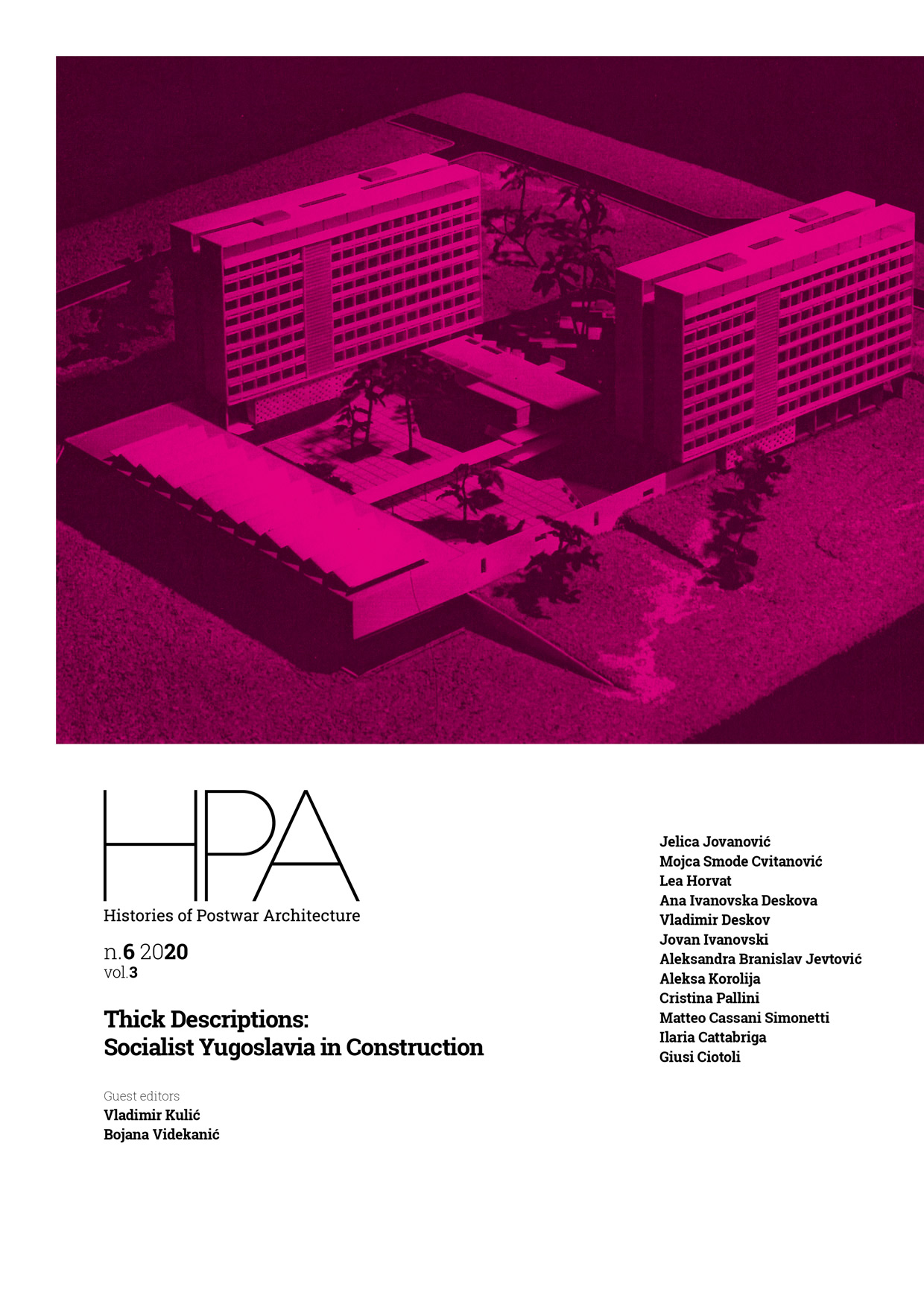Housing Yugoslav Self-Management: Blok 5 in Titograd
DOI:
https://doi.org/10.6092/issn.2611-0075/10608Keywords:
mass housing, Yugoslavia, self-management, Montenegro, Mileta BojovićAbstract
Self-management was one of the ideological foundations in socialist Yugoslavia. The paper argues that Blok 5 (1977–1984) — a mass housing settlement in Titograd, Montenegro, designed by Mileta Bojović — can be considered one of the theoretically and practically most enduring examples of self-management in Yugoslav mass housing. The concept can be traced from the urbanist blueprint, to the project proposal, the flexible floor plans and(over)stretched facades — exploring varying depths and levels of innovation. Furthermore, it outlines key differences between Yugoslav and Western Marxist understandings of agency, highlights frictions between different stakeholders in the construction processand explores the diverging post-socialist afterlives of self-management.
Downloads
References
Archer, Rory. “Imaš kuću — vrati stan. Housing inequlities, socialist morality and discontent in 1980s Yugoslavia.” Godišnjak za društvenu istoriju 20, no. 3 (2013): 119—39.
Burzan, Danilo. Istorija Podgorice. Kronologija događaja. Podgorica: Sektretarijat za kulturu i sport Glavnoga grada Podgorica, 2016.
Culler, Jonathan. Literary Theory: A Very Short Introduction. Oxford: Oxford University Press, 2000.
Damljanović Conley, Tanja and Jelica Jovanović. “Belgrade Residential Architecture 1950-1970: A Privileged Dwelling for a Privilege-Free Society.” In Unfinished Modernisations: Between Utopia and Pragmatism, edited by Maroje Mrduljaš and Vladimir Kulić, 298—311. Zagreb: Udruženje hrvatskih arhitekata, 2012.
Dragović, Sonja. “Budite realni — tražite nemoguće! Razgovor s autorom arhitektonskog rješenja Bloka 5: arh. Mileta Bojović.” In Pristup izradi planskog dokumenta: Učešće javnosti u planiranju Bloka 5 u Podgorici, edited by Milica Vujošević, Jelena Rabrenović and Sonja Dragović, 17—26. Podgorica: KANA, 2017.
Džokić Ana, Marc Neelen (Stealth. Unlimited) and Nebojša Milikić. “Kaluđerica From Šklj to Abc: A Life in the Shadow of Modernisation.” In Unfinished Modernisations: Between Utopia and Pragmatism, edited by Maroje Mrduljaš and Vladimir Kulić, 276—91. Zagreb: Udruženje hrvatskih arhitekata, 2012.
Forty, Adrian. Words and Buildings: A Vocabulary of Modern Architecture. London: Thames&Hudson, 2000.
Geertz, Clifford. The Interpretation of Cultures. New York: Basic Books, 1973.
Grandits, Hannes, and Holm Sundhaussen. “Jugoslawien in den 1960er Jahren: Wider einen teleologischen Forschungszugang.” In Jugoslawien in den 1960er Jahren. Auf demWeg zu einem (a)normalen Staat?, edited by Hannes Grandits and Holm Sundhaussen, 3—14. Wiesbaden: Harrasowitz, 2013.
Jakovljević, Branislav. Alienation Effects: Performance and Self-Management in Yugoslavia, 1945-91. Ann Arbor: University of Michigan Press, 2016.
Jančar, Barbara. “Ecology and Self-Management: A Balance-Sheet for the 1980s.”In Yugoslavia in Transition: Choices and Constraints, edited by John B. Allcock, John J. Horton and Marko Milivojević, 337—64. Oxford: Berg, 1992.
Jovićević, Ivan. “Blok 5 u Podgorici — istorijat i značaj.” In Pristup izradi planskog dokumenta: Učešće javnosti u planiranju Bloka 5 u Podgorici, edited by Milica Vujošević, Jelena Rabrenović and Sonja Dragović, 13—16. Podgorica: KANA, 2017.
Kardelj, Edvard. Problemi naše socialistične graditve: Knjiga V. Ljubljana: Državna založba Slovenije, 1963.
Kardelj, Edvard. Problemi naše socialistične graditve: Knjiga VII. Ljubljana: Državna založba Slovenije, 1968.
Kulić, Vladimir, Maroje Mrduljaš, and Wolfgang Thaler. Modernism In-Between: The Mediatory Architectures of Socialist Yugoslavia. Berlin: Jovis, 2012.
Lefebvre, Henri. The Production of Space. Translated by Donald Nicholson-Smith. Oxford and Cambridge: Blackwell, 1991.
Main project with technical report for Blok 5, “Stambeni objekti E1, B1, C1, G1 i C3 — Blok 5 — Titograd. Glavni projekat — Tehnički izvještaj,” 1980, PG-80-03B. Archives of the Republic Institute for Urbanism and Spatial Planning (RZUP), Podgorica, Montenegro.
Ramet, Sabrina P. Nationalism and Federalism in Yugoslavia 1962—1991. Bloomington: Indiana University Press, 1992.
Ražnatović, Sonja. Jana, samo privremeno u Bloku 9. Cetinje: OKF, 2016.
Richter, Vjenceslav. Sinturbanizam. Zagreb: Mladost, 1964.
Rudolph, Nicole C. At Home in Postwar France: Modern Mass Housing and the Right to Comfort. Oxford and New York: Berghahn, 2015.
Seferagić, Dušica. Kvaliteta života i nova stambena naselja. Zagreb: Sociološko društvo Hrvatske, 1988.
Sekulić, Dubravka. “Legitimacy and the extralegal: Expanding the thin line between legal and illegal in the densification of post-Yugoslav cities.” In Nadogradnje: Urban Self-Regulation in Post-Yugoslav Cities, edited by Sven Quadflieg and Gregor Theune, 126—39. Weimar: M Books, 2015.
Sher, Gerson S. Praxis. Marxist Criticism and Dissent in Socialist Yugoslavia. London and Bloomington: Indiana University Press, 1977.
SO Titograd fonds, SO-Titograd-19786, box 126. State Archives of Montenegro, Podgorica, Montenegro.
Unkovski-Korica, Vladimir. “Self-management, Development and Debt: The Rise and Fall of the 'Yugoslav Experiment’.” In Welcome to the desert of post-socialism: radical politics after Yugoslavia, edited by Srećko Horvat and Igor Štiks, 21—44. London: Verso, 2015.
Vasić, Zdenka. “Samoupravno planiranje.” Urbanizam Beograda 8, no. 37 (1976): 20—21.
Vujošević, Milica. “Učešće javnosti u urbanističkom planiranju — primjer Bloka 5 u Podgorici.” In Pristup izradi planskog dokumenta: Učešće javnosti u planiranju Bloka 5 u Podgorici, edited by Milica Vujošević, Jelena Rabrenović and Sonja Dragović, 43—70. Podgorica: KANA, 2017.
Vuković, Slobodan. “Stan po mjeri čovjeka.” Pobjeda, February 4, 1979.
Zaccaria, Benedetto. “Learning from Yugoslavia? Western Europe and the Myth of Self-Management (1968–1975).” In Planning in Cold War Europe: Competition, Cooperation, Circulations (1950s-1970s), edited by Michel Christian, Sandrine Kott and Ondrej Matejka, 213—35. Berlin and Boston: De Gruyter, 2018.
Downloads
Published
How to Cite
Issue
Section
License
Copyright (c) 2020 Lea Horvat

This work is licensed under a Creative Commons Attribution 4.0 International License.





